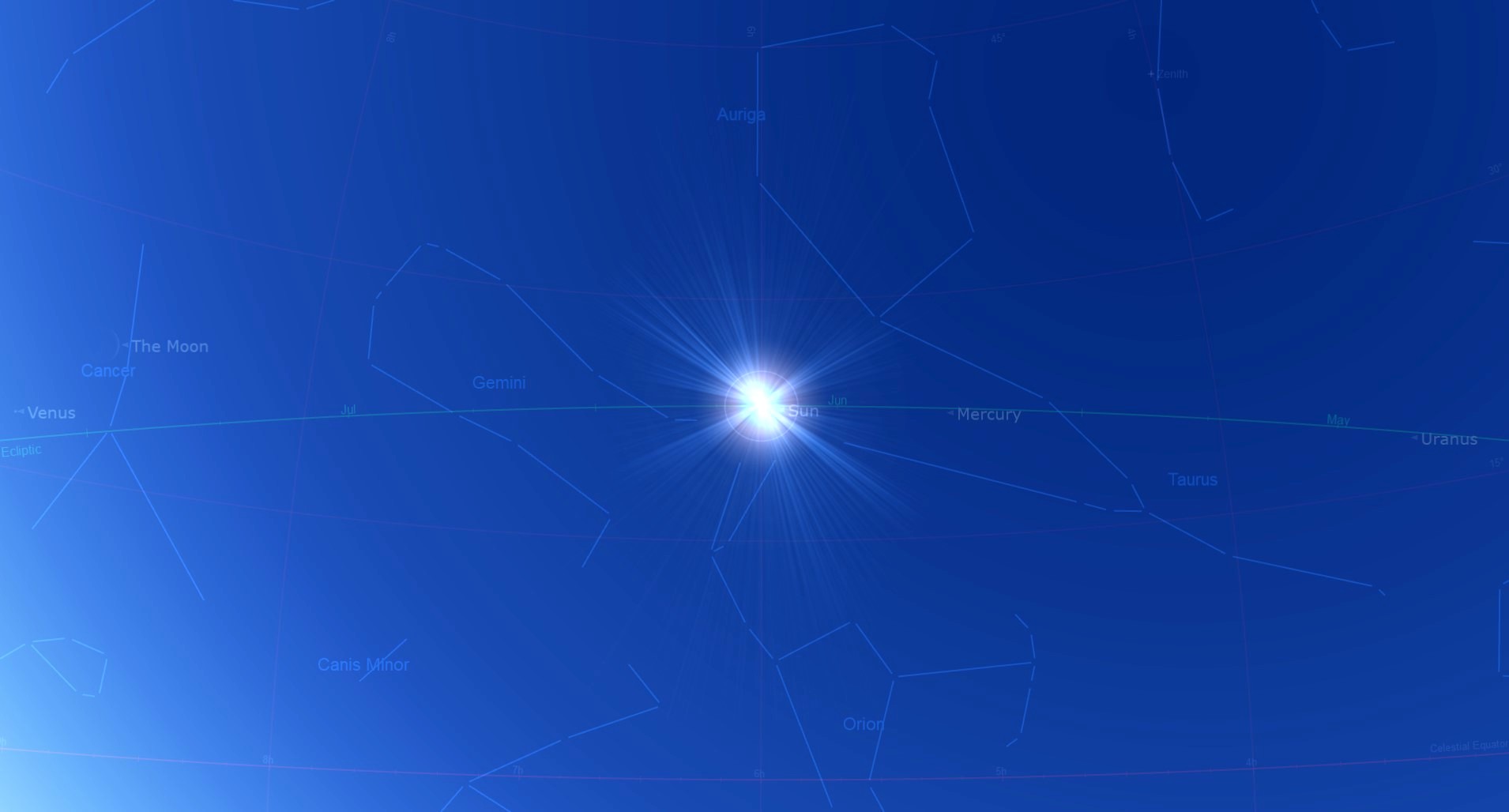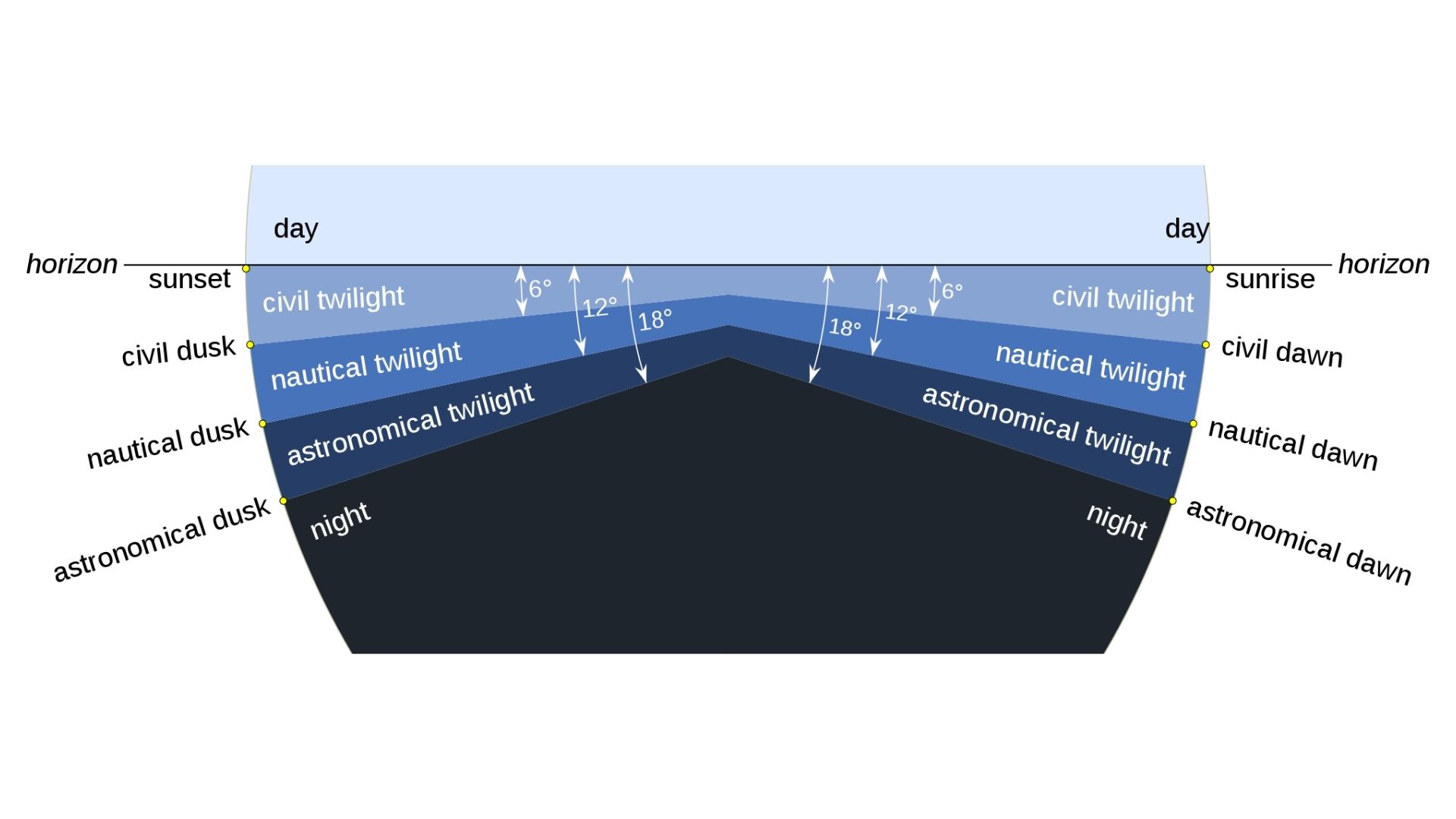
Summer will arrive with the solstice on Wednesday, June 21 at 10:58 a.m. EDT (1458 GMT); that moment when the sun shines directly down over the Tropic of Cancer (latitude 23.5 degrees north). At that time, the sun would appear to shine directly overhead for a ship in the North Atlantic Ocean, 1,470 miles (2,360 kilometers) east-southeast from San Juan, Puerto Rico.
You can't even note the change in the daylight span, which will be virtually the same on Tuesday and Wednesday, and diminishing to just half an hour during the next month.
Many publications note that at the time of the June Solstice, for Northern Hemisphere localities, the days are the longest and the nights shortest, but in the strictest sense, this statement is only half true. As an example, from New York City (latitude 41 degrees north), the sun on June 21 will be above the horizon for 15 hours and 6 minutes. But can we really refer to the remaining 8 hours and 54 minutes as "night?"
Not if we factor twilight into this equation.
Actually . . . three twilight zones
Certainly, after the sun disappears beyond the west-northwest horizon during the evening hours, the sky does not immediately become completely dark; nor is it totally dark until the moment that the sun emerges from the east-northeast horizon during the morning. We can thank our atmosphere for that. Twilight is defined as the diffused light from the sky during the early evening or early morning when the sun is below the horizon and its light is refracted by the Earth's atmosphere.
During the course of the year, the length of twilight can vary, but at this time of the year, for those in the Northern Hemisphere, it persists for the longest interval of time. Astronomers categorize twilight into three specific stages:
Civil twilight
Civil twilight is defined to begin in the morning, and to end in the evening when the center of the sun is geometrically 6 degrees below the horizon (your clenched fist held at arm's length measures roughly 10 degrees in width); about 30 to 40 minutes before sunrise or after sunset. Civil Twilight is the limit at which illumination is sufficient, under good weather conditions, for terrestrial objects to be clearly distinguished.
Get the Space.com Newsletter
Breaking space news, the latest updates on rocket launches, skywatching events and more!
Under a clear sky, at the beginning of morning civil twilight, or end of evening civil twilight, the horizon is clearly defined and the very brightest stars and planets (such as Sirius, Jupiter and Venus) are visible under good atmospheric conditions. In the morning before the beginning of civil twilight and in the evening after the end of civil twilight, artificial illumination is normally required to carry on ordinary outdoor activities.
In some newspapers on their weather page, you'll find a notation about when to turn on your car's headlights. That time is usually the end of civil twilight. Back in the day before lights became ubiquitous at most major league baseball parks, an extra inning afternoon game that ran past sunset would be called on account of darkness around the time of the end of civil twilight. Of course, this all is dependent on sky conditions; under a heavily overcast sky, it would get dark much sooner.
Nautical twilight
Nautical twilight is defined to begin in the morning and to end in the evening, when the center of the sun is geometrically 12 degrees below the horizon; about 60 to 80 minutes before sunrise or after sunset. At the beginning or end of nautical twilight, under good atmospheric conditions and in the absence of other illumination, general outlines of ground objects may be distinguishable, but most outdoor activities are not possible, and the horizon is indistinct. In New York City, the annual Independence Day fireworks show staged by Macy's Department Store usually does not get underway until around 9:30 p.m., near the end of nautical twilight.
Astronomical twilight
Astronomical twilight is defined to begin in the morning and to end in the evening when the center of the sun is geometrically 18 degrees below the horizon; about 90 to 120 minutes before sunrise or after sunset. Before the beginning of astronomical twilight in the morning and after the end of astronomical twilight in the evening the sun does not contribute to sky illumination. Admittedly, for a considerable interval after the beginning of morning twilight and before the end of evening twilight, any sky illumination is quite faint and somewhat difficult to perceive. Still, not until after astronomical twilight ends in the evening, or just before it begins in the morning can we say that the sky is indeed totally dark.
From New York City, at the June Solstice, the entire span of twilight lasts 2 hours and 6 minutes before sunrise and for a similar interval after sunset. So, of the nearly nine hours that the sun is below the horizon, it is totally dark for just 4 hours and 43 minutes.

Big differences between north and south
And for every degree that one goes north of latitude 40 north, the length of twilight increases by an average of almost 12 minutes. At latitude, 48.7 degrees north, twilight lasts 3 hours and 44 minutes, and north of there, twilight lingers through the entire night. From London, England (latitude 51.5 degrees north), twilight persists through the entire night from May 23 to July 18. From Edmonton, Alberta, Canada (latitude 53.6 degrees north) it runs from May 13 through July 28.
And at Fairbanks, Alaska (latitude 64.8 degrees north), perpetual twilight runs from April 8 through Sept. 2. In fact, from May 20 through July 23, the sky remains so bright that few, if any bright stars or planets can be seen. Just a little farther to the north, lies the Arctic Circle, the southern extremity of the "midnight sun." North of the Arctic Circle, the sun remains above the horizon for 24 continuous hours at least once per year.
Yet, in stark contrast to these far-northern locations, if you were to travel south to the tropics for a summer vacation in the coming weeks, you likely be struck by how quickly it gets dark after sundown. Let's say, as an example, you plan to be in Honolulu on Independence Day. The sunset that evening is at 7:17 p.m. Hawaii Time and astronomical twilight will end at 8:41 p.m. Yet only about an hour after sunset, a good number of stars will already be visible in the darkening sky.
Joe Rao serves as an instructor and guest lecturer at New York's Hayden Planetarium. He writes about astronomy for Natural History magazine, the Farmers' Almanac and other publications. Follow us on Twitter @Spacedotcom and on Facebook.
Join our Space Forums to keep talking space on the latest missions, night sky and more! And if you have a news tip, correction or comment, let us know at: community@space.com.

Joe Rao is Space.com's skywatching columnist, as well as a veteran meteorologist and eclipse chaser who also serves as an instructor and guest lecturer at New York's Hayden Planetarium. He writes about astronomy for Natural History magazine, Sky & Telescope and other publications. Joe is an 8-time Emmy-nominated meteorologist who served the Putnam Valley region of New York for over 21 years. You can find him on Twitter and YouTube tracking lunar and solar eclipses, meteor showers and more. To find out Joe's latest project, visit him on Twitter.









